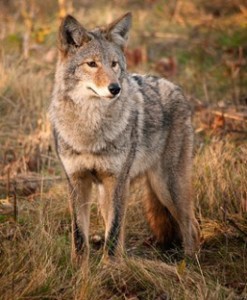 Several Reston-area residents have reported coyote sightings in the area in recent days.
Several Reston-area residents have reported coyote sightings in the area in recent days.
While there is no way to verify whether the animals were actually coyotes, the reports have similarities, and Fairfax County wildlife officials say they are getting an increase in the number of calls reporting coyotes countywide.
Wildlife officials say coyotes are established and widespread in Fairfax County.
A resident of Becontree Lane contacted Reston Patch last week to say she saw a coyote in her backyard near a wooded area.
“At first I thought it was a fox because we’ve seen those, but no bushy tail and the face and coloring were different,” the resident said. “Seeing the coyote photo on your article, I now know it was a coyote!”
More recently, several Fox Mill Woods residents say they saw coyotes in that area off of Lawyers Road in the last few days.
Abby Reed told her neighbors on a neighborhood message board that she saw a coyote on Blue Spruce near Riders Lane about 7:15 p.m. Sunday. Another neighborhood resident, Eliza Beaulac, said she saw one hit by a car on Sunset Hills Road near Target on Monday.
Another Fox Mill Woods resident said this after his dog was making lots of noise about 11:15 p.m. Monday night: “I saw either a very large fox or a coyote in the tip of the park behind my backyard between Grey Birch and Blue Spruce. … I put my head over with a flashlight and shined it right into the animal’s eyes about 50 feet away. It looked to be the size of a husky when it finally turned to the side and decided to leave. I haven’t seen a fox that big so either it was a loose dog or a coyote.”
County wildlife officials say keep an eye on your house pets just to be safe.
“The best way to safeguard pets in areas where coyotes are active is to keep them indoors and do not leave them outside without supervision,” Katherine Edwards, Fairfax County Wildlife Management Specialist, said in a release.
Coyotes are territorial and may view larger dogs as potential competitors, particularly from January to June while mating and birthing pups.
Coyotes are opportunistic foragers with diverse diets that commonly prey on small animals such as mice, rats, voles and rabbits but will also readily eat fruits, plants and carrion, says Edwards.
Coyotes may mistake small, unattended pets including cats and small dogs as prey due to their similar size to natural prey.
In suburban areas like Reston, most coyotes will be looking for available food or den sites.
Wildlife specialists say residents should take precautions to minimize encounters with people and their pets. That includes these tops:
- Never feed or attempt to “tame” a coyote.
- Place garbage and compost in an animal-proof container, such as a metal trash can with latches on the lid or secure with bungee cords.
- Keep trash inside until the morning of trash pick-up whenever possible.
- Do not feed pets outside or store pet food outside.
- Pick up ripe, fallen fruit and do not let it accumulate on the ground.
- Put away bird feeders at night to avoid attracting small rodents and other coyote prey.
- Trim shrubbery to ground level to remove hiding cover.
- Close up all openings under porches/decks, crawl spaces or out-buildings where animals might establish dens.
- Keep small pets inside and do not leave unattended when outside.
- Keep dogs on short leashes (less than 6 feet) while walking outside.
- Provide secure shelters for poultry, rabbits, and other vulnerable animals.
- Be alert at dusk and dawn. Coyotes are most active at night and early morning hours; however, they may be active during the day in search of food or denning sites.
What to do if you see a coyote? Officials say use “hazing techniques” to frighten coyotes from the property.
- Yell and wave your arms at the coyote.
- Use noisemakers such as whistles, air horns, bells, “shaker” cans full of marbles or pennies, or pots and pans banged together.
- Throw non-edible objects in the direction of the coyote including sticks, small rocks, cans, or tennis balls.
- Spray the coyote with a water hose, water guns or spray bottles with vinegar water, pepper spray or bear repellent.
- Install motion sensor lights or a motion-activated sprinkler around your home.
- Install fencing to keep coyotes out of yards. Fencing should be at least 6 feet tall, have an outward slanting overhang or roller-type device to prevent coyotes from climbing or jumping, and have an L-shaped mesh apron buried one to two feet to deter digging. Few fences are completely coyote-proof.
If these techniques do not solve the problem, Virginia regulations allow nuisance coyotes to be removed by a licensed trapper or critter removal service.
If you see a coyote that is behaving aggressively or appears sick or injured, contact the Fairfax County Police non-emergency number at 703-691-2131.
Coyote picture courtesy of Fairfax County Police





